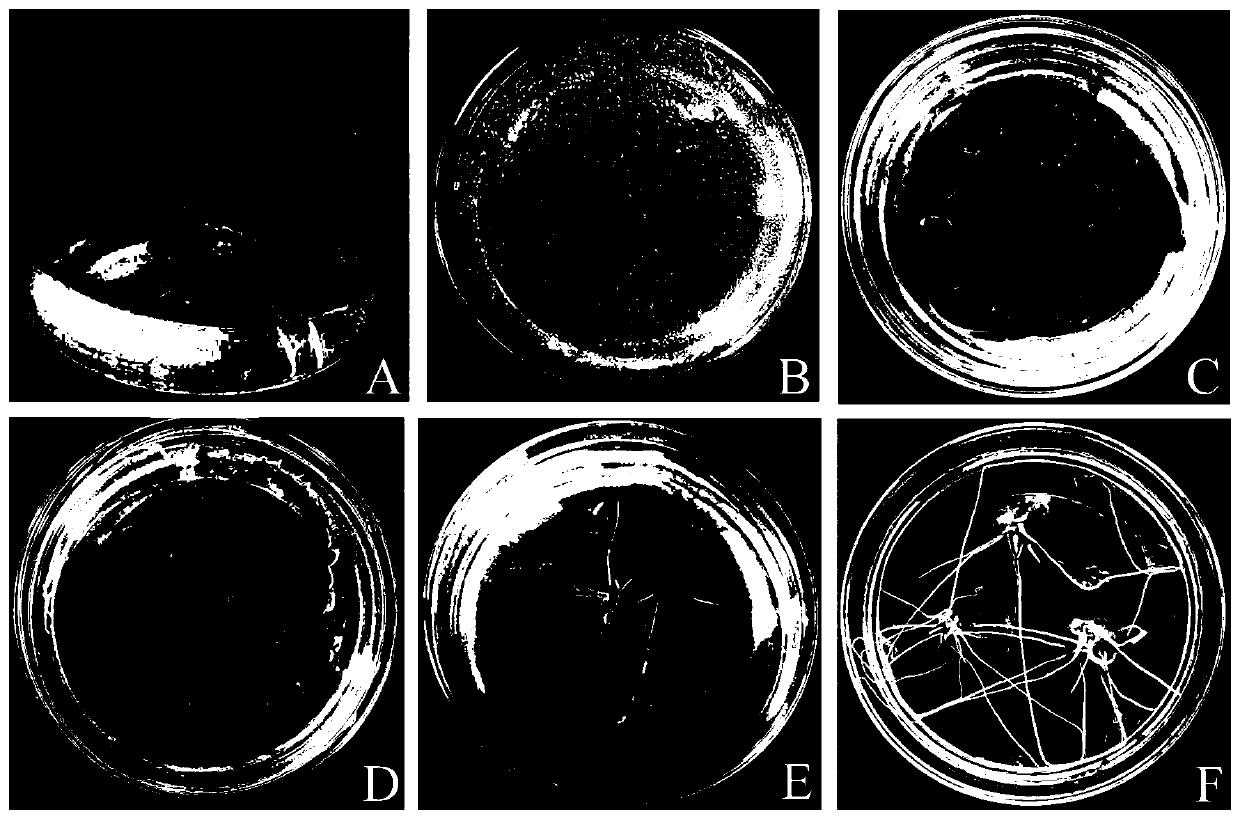Method for inducing ardisia crenata to generate hairy roots by efficiently utilizing agrobacterium rhizogenes
A technology of Agrobacterium rhizogenes and hairy roots, which is applied in the field of genetic transformation and plant tissue culture, can solve the problems of shortening the culture time and achieve the effect of high induction rate and simple operation
- Summary
- Abstract
- Description
- Claims
- Application Information
AI Technical Summary
Problems solved by technology
Method used
Image
Examples
Embodiment 1
[0033] A method for efficiently utilizing Agrobacterium rhizogenes to induce cinnabar roots to produce hairy roots, comprising the steps of:
[0034] 1) Activation of Agrobacterium rhizogenes ( figure 1 ):
[0035] Agrobacterium rhizogenes strain ATCC 15834 stored at -80°C in YMB+Amp 50mg·L -1 Stretch on the solid medium, place in an electric thermostat incubator at 28°C and culture in the dark until a single plaque grows, pick a single plaque in YMB+Amp 50mg L -1 In the liquid culture medium, place it in an air bath constant temperature shaker at 180rpm, 28°C and cultivate in the dark until the liquid is turbid, then streak again, pick a single plaque, and culture in liquid. This step is repeated twice. After liquid culture, suck 1mL of bacteria solution in a 100mL conical flask (containing 50mLYMB+Amp 50mg·L -1 +AS 100μmol·L -1 liquid medium) to OD 600 When the value is 0.5-0.8 (spectrophotometer), the Agrobacterium rhizogenes competent cells are prepared for dip-mediat...
experiment example 1
[0043] The induction dynamic parameter and the morphological feature statistics of embodiment 1 induction gained cinnabar root hairy root and tissue culture seedling root (control group), statistical method and result are as follows:
[0044] Table 1
[0045]
[0046] Table 2
[0047]
[0048]
[0049] Note: ACRC is the abbreviation of cinnabar root tissue culture seedling root, and ACHR is the abbreviation of cinnabar root hairy root induced by Agrobacterium rhizogenes ATCC 15834;
[0050] The data statistics method is as follows:
[0051] Induction rate (%)=number of rooted explants / number of inoculated explants×100%;
[0052] Browning rate (%) = number of browned explants / number of inoculated explants × 100%;
[0053] Callus rate (%) = number of callus explants / number of inoculated explants × 100%;
[0054] Pollution rate (%) = number of polluted explants / number of inoculated explants × 100%;
[0055] Mortality rate (%)=number of dead explants / number of inocul...
experiment example 2
[0064] The content of cinnabar root saponins in different tissues of cinnabar root was detected, and the results are shown in Table 3.
[0065] Table 3 Cinnabar root saponin content in different tissues of cinnabar root
[0066]
[0067] Therefore it can be seen that the removal of Amp 50mg L in Comparative Example 1 -1 The induction rate of cinnabar root hairy roots will be significantly reduced. In comparative example 2, no addition of cefotaxime sodium Cef can not achieve a good sterilization effect, and the explants will die soon due to contamination, and hairy roots cannot be induced. Do not get any cinnabar root saponins.
PUM
 Login to View More
Login to View More Abstract
Description
Claims
Application Information
 Login to View More
Login to View More - R&D
- Intellectual Property
- Life Sciences
- Materials
- Tech Scout
- Unparalleled Data Quality
- Higher Quality Content
- 60% Fewer Hallucinations
Browse by: Latest US Patents, China's latest patents, Technical Efficacy Thesaurus, Application Domain, Technology Topic, Popular Technical Reports.
© 2025 PatSnap. All rights reserved.Legal|Privacy policy|Modern Slavery Act Transparency Statement|Sitemap|About US| Contact US: help@patsnap.com



